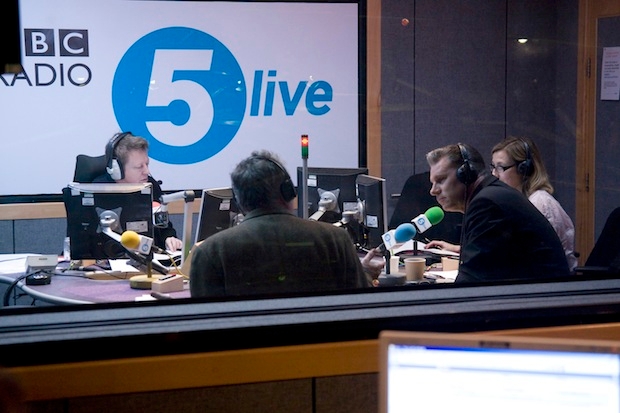It’s amazing to think that it’s 20 years since the launch of Radio 5 Live. But it was bright and early on the morning of 28 March 1994 (long before Princess Diana’s death, 9/11, the Iraq war, the London bombs, the Asian tsunami, the ‘Arab spring’) that Jane Garvey announced, ‘Welcome to a new network.’ Not an impersonal statement, ‘This is Radio 5 Live’, as you might have expected from the BBC. But an inviting ‘Welcome’. Come in. Join us. We want to hear from you, just as much as you are going to hear from us.
Interaction was what gave the station its USP, its distinctive character. Yet this was more than a decade before Twitter, Tumblr, Buzzfeed really took off. Mobile phones were still big, awkward, boxy things to use, with no internet access and no keyboard; iPads and tablets were off the radar.
The BBC was ahead of the game in realising that audience participation was essential to 5 Live’s success and the station now feels as much part of the Corporation’s radio output (with a weekly audience of 6.53 million) as the more aloof and statesmanlike 4 (with a weekly audience of 11.21 million). Yet it seems no time since we were wondering how a station could survive on nothing but news and sport — no comedy to lighten the mix, no music, no dramas, no stories — and for 24 hours, 1,440 minutes, each and every day. When it first aired there were no chatlines and webcams. It was long before podcasting, streaming, downloading. Before texting, too, had really taken off — mobile phones were used for talking to people, not sending them cryptic messages. How, you might ask, was the new station supposed to carry out its mission to communicate more with its listeners?
Through its speech-radio pros, of course. Journalists such as Jane Garvey, Peter Allen, Eddie Mair, Fi Glover gave those first days on air a professional ease combined with an authority that was markedly different — less Alvar Lidell, more a cross between Sue MacGregor, Jimmy Young and David Davies. They oozed chatty familiarity and an ability to reach out through the ether. They were beacons of the brave new world of interconnectedness but they made the station work because of their old-fashioned ability to wield the mike.
At first it seemed impossible to believe there was a radio vacuum for them to fill. Live and rolling news bulletins for 24 hours a day were first introduced as the first Gulf war unfolded in 1991 and it was thought necessary to keep the public informed minute-by-minute as to what was going on. There was a lot of chatter on Radio 4 News FM but not a great deal added to what was already being aired on Radio 4. What Radio 5 Live managed to create, under its inspired first controller Jenny Abramsky, was a day-long conversation that stayed buoyant, original and above all engaged with its listeners. Plus, of course, it has always had the lure of all that ‘live’ sports action without having to pay a hefty subscription (only a licence fee).
The 5 Live effect (have a listen on YouTube to Shelagh Fogarty dealing with a live mouse running round the studio while on air and notice how at ease she is in letting her listeners know what’s going on) has rippled through the other networks, softening 4, sharpening up 2. You could say it’s responsible for Radio 3’s dabbling in new media, constantly informing us that so-and-so from outer space has been in touch about their memories of first hearing The Planets. But there’s only so long you can hold back the winds of change, and perhaps in time we’ll learn to forgive 3 for succumbing to what 5 Live has pioneered for the BBC.
One thing I would miss if all the other networks were switched off and we were left only with 5 Live to listen to would be those 15-minute shorts, beloved of 4 and 3, filled with stories, profiles, mini-dramas, or pithy essays. The last few Friday afternoons on Radio 4 have given us a series of four short stories by new Irish writers. Yesterday’s offering, Jigsaw by Martin Meenan (read by Ciaran McMenamin), was deceptively simple but so vivid in the mind. A young boy visits his grandfather on Saturdays, dropped off by his father on his way to work. No mention of the mother. Bored by the inactivity, the heavy old-age atmosphere, he finds a pile of boxes filled with jigsaws underneath the sideboard and begins to do the puzzles with his grandfather. But each time they begin a new picture his grandfather surreptitiously hides one piece, only producing his own hand-made version of the missing piece when the puzzle is almost done. The boy wonders why? Not much happens, even less is said, but the story lingers on in the mind. When the grandfather dies, the boy finds upstairs hidden away… On second thoughts, you should go find New Irish Writing on iPlayer.






Comments